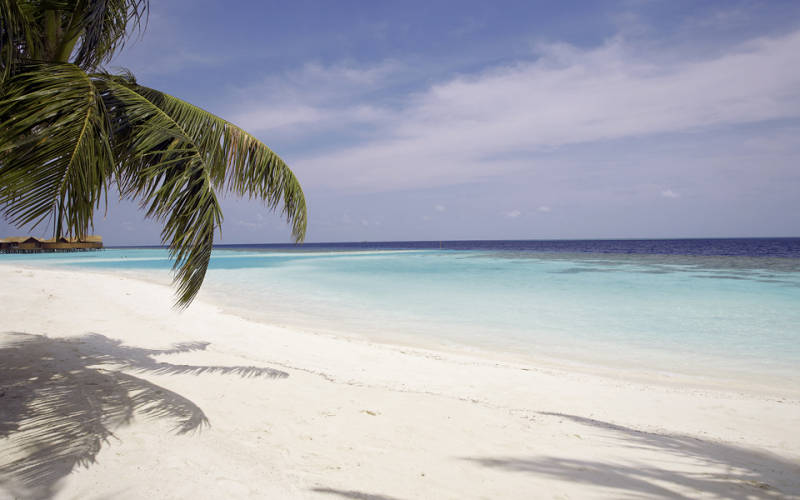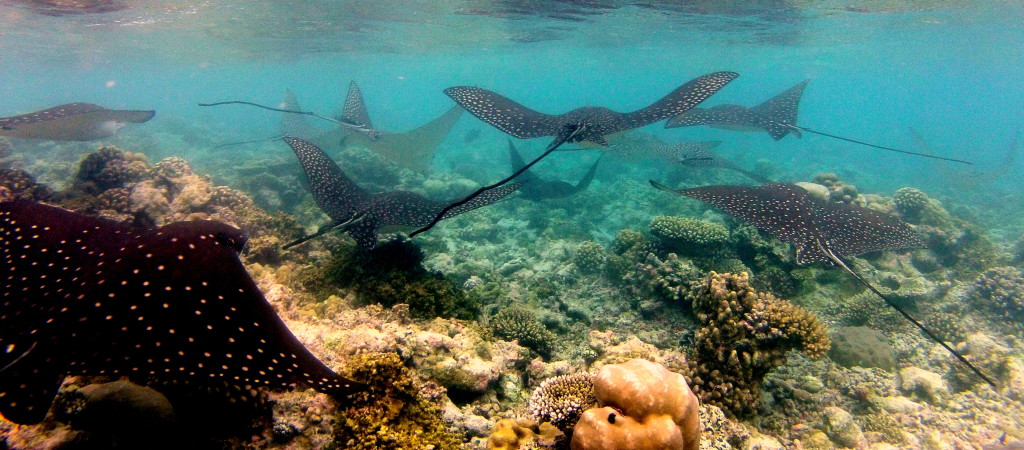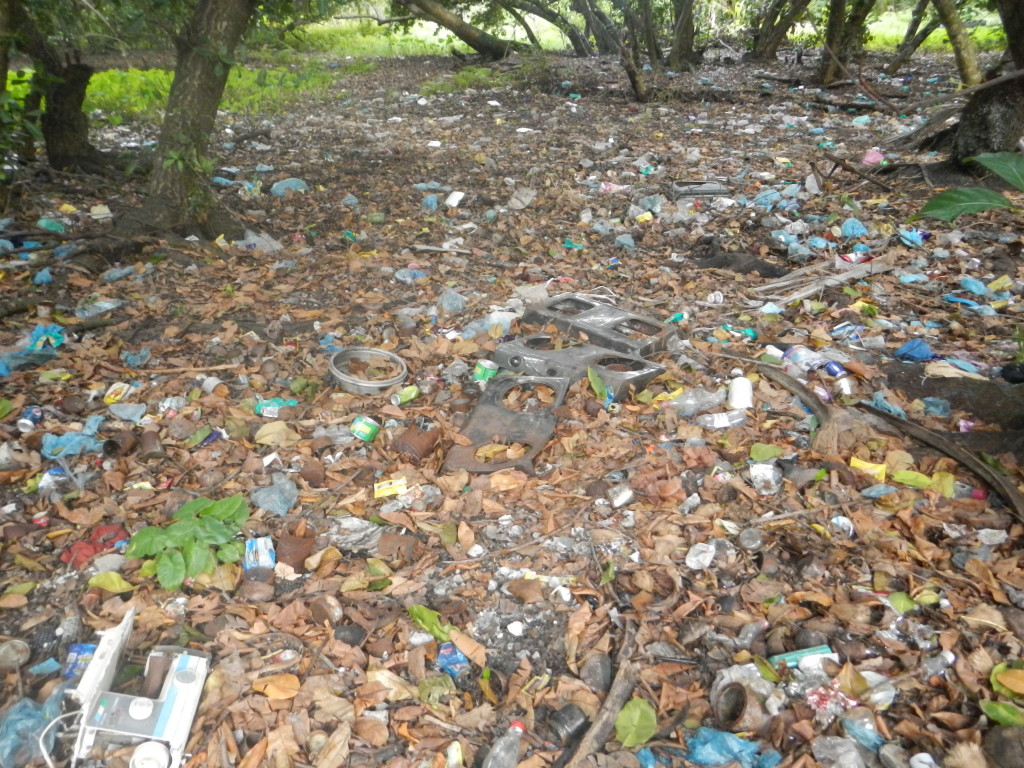Marine Life & Conservation
Marine conservation in the Indian Ocean

Introduced by Jeff Goodman
Each year more people look for exotic destinations to take their holidays and dive trips and so the human impact on these pristine places takes a terrible toll. Reef destruction, over fishing, uncontrolled development, pollution from human waste… the list is almost endless. So who is ultimately responsible? Local government? Tour operators? Resort companies? Tourists? We all tend to pass the buck while at the same time making as much profit as possible before the golden goose eventually gets choked to death. In the Maldives at least, these issues are starting to be being taken seriously.
The Maldives, called “the flower of the Indies” by Marco polo, is suffering today from new developments and an increased population, including tourism, which together with climate change will synergistically impact on the marine environment.
The Maldives constitutes together with the Laccadives the largest and most extensive chain of atolls on the planet with less than 4% of the territory being dry land, so by joining the two most important forces that drive the country together, conservation and tourism, a long term sustainability of the marine environment can be obtained.
This country is the most imminently threatened by rising seas caused by climate change, so the Maldives has to be prepared for climate change as past emissions will increase global temperatures by up to 0.60º C over the next four decades, so not only must our awareness of climate change increase, so must our need to understand the changes it will bring and our vulnerability to it. Other activities practiced in the Maldives such as coral mining, pollution and unregulated fishing are already impacting on the marine environment, so understanding the effects of temperature increase and ocean acidification is of extreme importance.
A country that is no longer relying on their tuna fishery for survival but depend on resort islands and incoming tourists for their livelihoods have to take care of their environment.
Speaking about the tourism in Male, Kuoni’s Head of Corporate Responsibility Matthias Leisinger once said that “tourism is like fire; you can cook with it, but it can also burn your house down.” The tourism industry generates about 30% of the country´s GDP. In 1998 a bleaching event caused almost 100 percent of mortality in some areas of the coral reefs and, compared to other countries where management was working really well, their recovery was much better than in the Maldives. “Incidents like this are likely to increase as stock diminishes everywhere” says another representative from the Ministry of Tourism in the Maldives. He also pointed out new challenges arising with the changing market profile of tourism in the country, since the European visitors do form part of taking care of the natural environment. However, “the market is changing, and the new market is constituted of guests that are walking on the reefs, catching and eating crabs….” “Maybe it is about time for the resorts “to take responsibility for the natural environment for the duration for the lease,” a representative from the Marine Research Centre (MRC) said. Adjustment is essential if the different sectors, including tourism, aim to reduce the vulnerability to climate change and limit its negative sides and so optimizing the resources to the local community to cope with these changes.
The two biggest threats to the Maldives are climate change and waste management.
Climate change and coral reefs resilience
● Coral Reefs in the Maldives
– The Maldives is home to around 60 different coral genera and has the highest coral diversity in the Indian Ocean. Perhaps due to its substratum or erupted lava, the Maldivian reefs appear to be qualitatively different from other shallow reefs in the Indian Ocean in the way that they are composed of branching Acropora in high abundance and diversity. The Maldives also have the highest temperatures of the Indian Ocean.
– The threats the coral reefs are facing in the Maldives are sedimentation and sewage stress from the bigger islands (from the harbors and airport). In addition to this, inappropriate fishing methodologies are increasing and impact the recovery rate of the reef from bleaching events, and together with the global climate change is the biggest threat nowadays. The impact and the long-term possible recovery of reefs are directly related to overall health of coral reefs.
– For local and national managers to be able to act in response to these threats it is therefore of extreme importance to have monitoring protocols.
Monitoring Protocols
A number of protocols have been developed by the Marine Research Center, the Darwin Initiative, and the Great Barrier Marine Park Authority to monitor reef fisheries and coral bleaching in which corals expel the algal cells (zooxanthellae), that under normal conditions live within their tissue. The Maldives has already experienced extensive climate related damage to their reefs, where other reefs recovered better under similar circumstances, therefore an accurate management and understanding of Coral Reef health has to be implemented around the whole country.
Bleach Watch
This protocol has been developed to detect and measure conditions and events of coral bleaching from a wide range of users like dive operators and resort staff, who over time can prepare available, reliable reports. Detecting early signs of mass bleaching events require a wide network of observers over a broad span of territory.
CPC
Counting the coral coverage and the coral diversity across the Maldives over time will provide the national government and resort managers with valuable information which can be used to understand and act in response to observed changes and threats to coral reef around the Maldives.
Reef Fisheries and the Darwin Reef Fish Project
It is important for the Maldives to obtain more knowledge about reef and fisheries in order to develop new management plans to maintain the Coral Reef’s health. The reef fish are important through herb ivory and predation and both overfishing and destructive fishing practices can alter the dynamics of the whole ecosystem. The Darwin Reef Fish Initiative together with the MRC have developed a new resources management plan, where spawning aggregations and fish home range can be detected to elaborate new management plans. The aquarium and bait fishery have guidelines, but there are no regulations for reef fish, apart from the protected Napoleon wrasse and parrotfish species. The reef fishery has to be managed properly to be sustainable and size limitations of reef fish are necessary, so by implementing this monitoring protocol, miss-reporting and under-reporting fish, like the Rainbow runner, is being sampled and measured to apply appropriate managing guidelines and so improve the resilience of the Coral Reefs.
Fish watch
A fish count and underwater visual census; it constitutes a tool to measure fish populations over time and location.
Fish Catch
A survey collecting information on number and weight of landed reef fish. Together with the measured size and the location of fishing, this gives information for developing marine protected areas. Data is also collected from night fishing practiced by guests of the resorts.
Shark Watch
A diver or snorkel-based recording of shark sightings at the dive or snorkel site on a daily basis. Since the sharks were almost depleted from its water or overfished due to their fins, the tourists are now demanding to see sharks, so since 2009 they have introduced shark protection.
Under the climate change trust fund with World Bank funding a new project is being implemented that will train and empower local community to monitor their coral reefs until September 2014.
A monitoring protocol is developing and a database is going to take shape for the entire country. With less than one per cent of the world’s oceans protected from exploitation and an estimation of that up to 80% of the world´s marine protected areas are only so called and not actively managed, it´s of urgent need to create properly managed and protected areas for the marine environment. All benefits of having marine protected areas are well known, such as conservation of the biodiversity and improvements of the local economy; however, it is so important for the future of the country, which is why a stakeholder approach is needed to monitor these areas and, if necessary, protect and preserve them.
Another issue to consider is how close they need to be, in order to promote connectivity between areas, and how many there should be, to provide a real protection for species. To enhance the resilience of the coral reef in the Maldives not only a reduction on pollution is needed, but also protection and managing existing marine areas properly, can work as an insurance for sustainability.
● Developing waste management systems on inhabited islands
– The Maldives is facing one very big human impact and that is waste management. In the shadow of Thilafushi Island, which is the waste island close to Male the capital, the local islands are struggling with waste processing and associated water quality problems. The Maldivian islands are scattered over a very large area, so distance combined with an increase in population and consumption make the waste management issue very important to resolve.
– A pioneer project involving four northern atolls cooperating to manage the waste at just one island is set up to start working in 2014. This will join resort islands and local islands together, and act as a pioneer project to relieve the burden of Thilafushi.
– By promoting this and taking care of waste closer to the islands where it originated, it is probable that less waste will be dumped in the ocean or buried in the sand or burned producing toxic gases.
– So by doing this, not only will the local islands’ reefs get more resilient by alleviating the human impact, but also the resort island will have less waste washed up on their beaches. This is a good example of both locals and tourists benefitting and eventually the entire economy and the environment.
– Money from separate sources will also be implemented in several projects to teach segregation of waste at household level, and bins will be provided to store the waste separately until removal from the island.
– Probably due to the fact that the islands have accumulated waste over time, a big clean up has to be organized to accomplish the objective of waste management.
The Maldives aims for a total protection of their waters and would like to proclaim the entire country a UNESCO biosphere reserve by 2017 and the country as a Marine Reserve by 2020. Let´s see how this amazingly beautiful country threatened by climate change and waste will manage with such big expectations.
Blogs
Invitation from The Ocean Cleanup for San Francisco port call

6 years ago, The Ocean Cleanup set sail for the Great Pacific Garbage Patch with one goal: to develop the technology to be able to relegate the patch to the history books. On 6 September 2024, The Ocean Cleanup fleet returns to San Francisco bringing with it System 03 to announce the next phase of the cleanup of the Great Pacific Garbage Patch and to offer you a chance to view our cleanup system up-close and personal.
We look forward to seeing you there.
To confirm your presence, please RSVP to press@theoceancleanup.com
PROGRAM
Join The Ocean Cleanup as our two iconic ships and the extraction System 03 return to San Francisco, 6 years and over 100 extractions after we set sail, to create and validate the technology needed to rid the oceans of plastic.
Our founder and CEO, Boyan Slat, will announce the next steps for the cleanup of the Great Pacific Garbage Patch. Giving you a chance to view our cleanup system and the plastic extracted.
Hear important news on what’s next in the mission of The Ocean Cleanup as it seeks to make its mission of ridding the world’s oceans of plastic an achievable and realistic goal.
Interviews and vessel tours are available on request.
PRACTICALITIES
Date: September 6, 2024
Press conference: 12 pm (noon)
Location: The Exploratorium (Google Maps)
Pier 15 (Embarcadero at Green Street), San Francisco, CA
Parking: Visit The Exploratorium’s website for details.
RSVP: press@theoceancleanup.com
Video & photo material from several viewing spots around the bay
We look forward to seeing you there!
ABOUT THE OCEAN CLEANUP
The Ocean Cleanup is an international non-profit that develops and scales technologies to rid the world’s oceans of plastic. They aim to achieve this goal through a dual strategy: intercepting in rivers to stop the flow and cleaning up what has already accumulated in the ocean. For the latter, The Ocean Cleanup develops and deploys large-scale systems to efficiently concentrate the plastic for periodic removal. This plastic is tracked and traced to certify claims of origin when recycling it into new products. To curb the tide via rivers, The Ocean Cleanup has developed Interceptor™ Solutions to halt and extract riverine plastic before it reaches the ocean. As of June 2024, the non-profit has collected over 12 million kilograms (26.4 million pounds) of plastic from aquatic ecosystems around the world. Founded in 2013 by Boyan Slat, The Ocean Cleanup now employs a broadly multi-disciplined team of approximately 140. The foundation is headquartered in Rotterdam, the Netherlands, and opened its first regional office in Kuala Lumpur, Malaysia, in 2023.
Find out more about The Ocean Cleanup at www.theoceancleanup.com.
Marine Life & Conservation
SHARK MONTH ARRIVES AT ROYAL WILLIAM YARD, PLYMOUTH

A shark has been spotted approaching Royal William Yard in Plymouth, much to the surprise of swimmers, paddleboarders and onlookers.
With its distinctive dorsal fin cutting through the water, the sizeable shark swam along the coastline, before turning to head inland towards Firestone Arch at Royal William Yard. The appearance drew a crowd, who were captivated for more than an hour by the unusual sight – and it was all caught on video.
The shark is one of many expected sightings at Royal William Yard over the coming weeks… because today marks the start of Shark Month!
In reality, the ‘shark’ spotted along the Plymouth shoreline was actually a custom-made model, created by the team at Royal William Yard and sailed underwater by Caroline Robertson‑Brown from the Shark Trust, who donned scuba diving gear for the occasion.
The stunt took place to launch Shark Month in style and draw attention to the work of the leading international conservation charity, which is based in Britain’s Ocean City. Spectators were reassured that the water was safe and many entered into the spirit of the performance, swimming or sailing alongside the shark.
Shark Month will take place across Royal William Yard throughout July and will feature an extravaganza of art, entertainment and advocacy for everyone to enjoy. The packed programme of events starts with an art exhibition and ends with a trip on paddleboards with shark experts – with everything from a shark quiz to a Jaws screening in between.
Paul Cox, CEO of the Shark Trust, said: “There are often assumptions and misconceptions when it comes to sharks. This was certainly the case with the shark spotted at Royal William Yard! While the British coastline is home to many species of shark, this was not one of them. However, we’re thrilled it caught people’s attention, because seeing a shark is a special and memorable moment. That is precisely why we want to celebrate these incredible creatures, highlight the need for conservation, and ask for help to safeguard their future.”
For more information about Shark Month at Royal William Yard, visit the Shark Trust Website.
Images and video: Jay Stone
-

 Blogs2 months ago
Blogs2 months agoDiving With… Nico, Ocean Earth Travels, Indonesia
-

 News1 month ago
News1 month agoMurex Bangka Announce New Oceanfront Cottages & Beachfront Dining
-

 Blogs2 months ago
Blogs2 months agoA new idea in freediving from RAID
-

 Marine Life & Conservation1 month ago
Marine Life & Conservation1 month agoIceland issue millionaire whale hunter a licence to murder 128 vulnerable fin whales
-

 Marine Life & Conservation2 months ago
Marine Life & Conservation2 months agoThe Shark Trust Great Shark Snapshot is back
-

 News3 months ago
News3 months agoCharting New Waters; NovoScuba Goes Global with the Launch of their Revolutionary Dive Training Agency!
-

 Gear News1 month ago
Gear News1 month agoNew Suunto Ocean – a dive computer and GPS sports watch in one for adventures below and above the surface
-

 Marine Life & Conservation Blogs2 months ago
Marine Life & Conservation Blogs2 months agoBook Review: Plankton


















